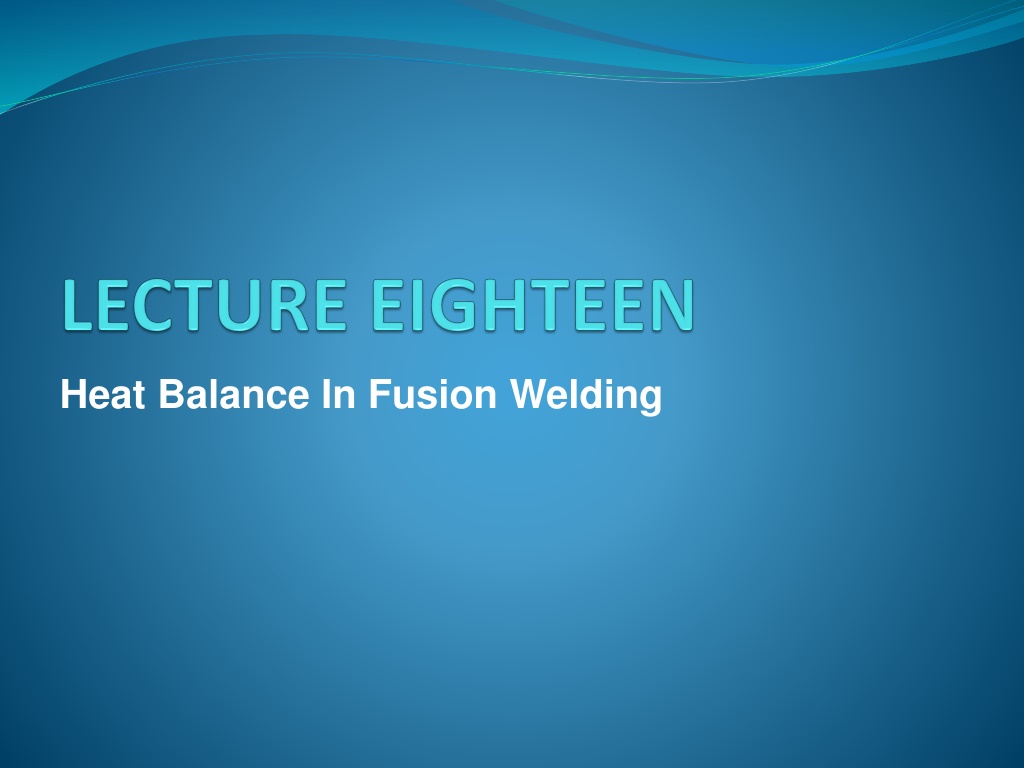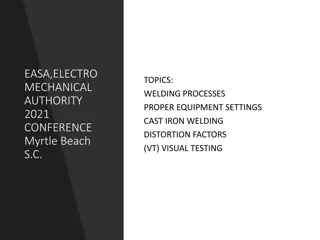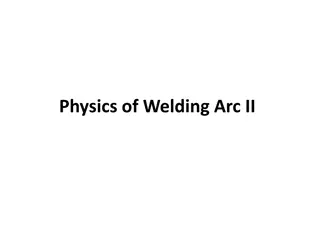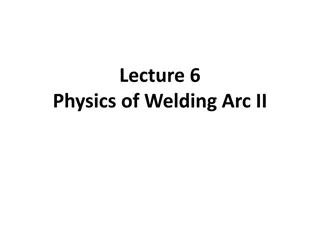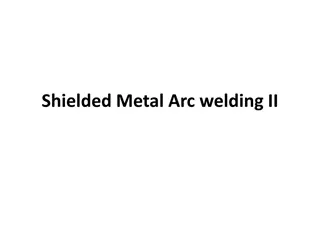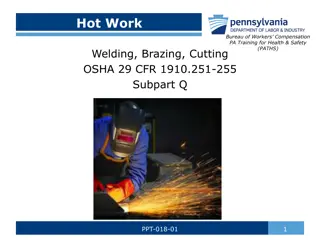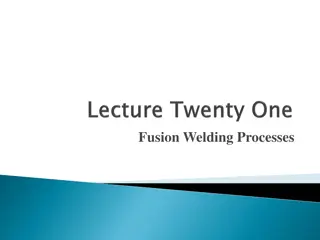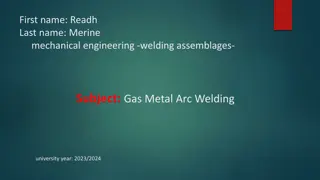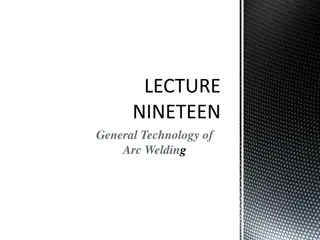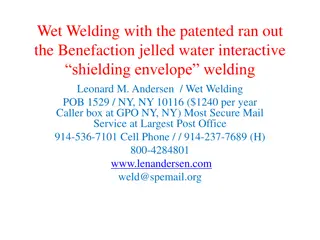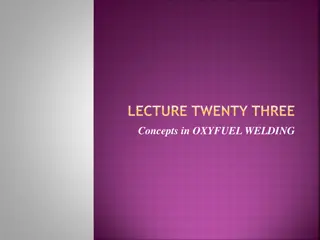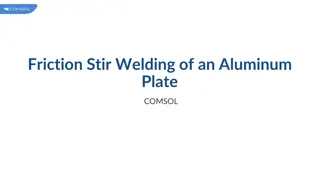Understanding Heat Balance in Fusion Welding
In fusion welding, the heat balance is crucial for melting the metal efficiently. Factors like heat transfer, melting point, and energy conversion affect the amount of heat available for welding. The combination of heat transfer and melting factors reduces the net heat available for welding, impacting the overall efficiency of the process. Different welding techniques and metal properties influence these factors, with high power density and low conductivity materials being advantageous for welding.
Download Presentation

Please find below an Image/Link to download the presentation.
The content on the website is provided AS IS for your information and personal use only. It may not be sold, licensed, or shared on other websites without obtaining consent from the author. Download presentation by click this link. If you encounter any issues during the download, it is possible that the publisher has removed the file from their server.
E N D
Presentation Transcript
Heat Balance In Fusion Welding The quantity of heat required to melt a given volume of metal depends on: The heat to raise the temperature of the solid metal to its melting point The melting point of the metal The heat to transform the metal from solid to liquid phase at the melting point. To a reasonable approximation, this quantity of heat can be estimated by the following equation: ??= ?Tm Where Um = the unit energy for melting (i.e., the quantity of heat required to melt a unit volume of metal starting from room temperature), J/mm3(Btu/in3); Tm = melting point of the metal on an absolute temperature scale, K (R ); and K=constant whose value is 3.33x10-6when the Kelvin scale is used (and K = 1.467 x 10-5for the Rankine temperature scale). Not all of the energy generated at the heat source is used to melt the weld metal. 18.1 2
There are two heat transfer mechanisms at work, both of which reduce the amount of generated heat that is used by the welding process. The situation is depicted in Figure 12.1. The first mechanism involves the transfer of heat between the heat source and the surface of the work. This process has a certain heat transfer factor f1, defined as the ratio of the actual heat received by the workpiece divided by the total heat generated at the source. The second mechanism involves the conduction of heat away from the weld area to be dissipated throughout the work metal, so that only a portion of the heat transferred to the surface is available for melting. This melting factor f2is the proportion of heat received at the work surface that can be used for melting.
The combined effect of these two factors is to reduce the heat energy available for welding as follows: 18.2 ??= ?1?2H Where Hw= net heat available for welding, J (Btu), f1= heat transfer factor, f2 = the melting factor, and H = the total heat generated by the welding process(welding source) , J (Btu). The factors f1and f2range in value between zero and one. It is appropriate to separate f1and f2in concept, even though they act in concert during the welding process. The heat transfer factor f1is determined largely by the welding process and the capacity to convert the power source (e.g., electrical energy) into usable heat at the work surface. Arc-welding processes are relatively efficient in this regard, while oxyfuel gas-welding processes are relatively inefficient.
The melting factor f2depends on the welding process, but it is also influenced by the thermal properties of the metal, joint configuration, and work thickness. Metals with high thermal conductivity, such as aluminum and copper, present a problem in welding because of the rapid dissipation of heat away from the heat contact area. The problem is exacerbated by Welding heat sources with low energy densities (e.g., oxyfuel welding) because the heat input is spread over a larger area, thus facilitating conduction into the work. In general, a high power density combined with a low conductivity work material results in a high melting factor
We can now write a balance equation between the energy input and the energy needed for welding: ??= ??? Where Hw= net heat energy used by the welding operation, J (Btu); Um = unit energy required to melt the metal, J/mm3(Btu/in3); and V= the volume of metal. In the welding of a continuous bead, the volume rate of metal welded is the product of weld area Awand travel velocity v. the rate balance equation can now be expressed as ???= ?1?2??= ????? Where RHw=rate of heat energy delivered to the operation for welding, J/s= W(Btu/min);f1and f2are the heat transfer and melting factors; RH= rate of input energy generated by the welding power source, W (Btu/min); Aw= weld cross- sectional area, mm2(in2); and v = the travel velocity of the welding operation, mm/s (in/min). 18.3 18.4
Example1 The power source in a particular welding setup generates 3500W that can be transferred to the work surface with a heat transfer factor = 0.7. The metal to be welded is low carbon steel, whose melting temperature is 1760K. The melting factor in the operation is 0.5.A continuous fillet weld is to be made with a cross-sectional area=20mm2. Determine the travel speed at which the welding operation can be accomplished. Sol: Let us first find the unit energy required to melt the metal Umfrom Eq. (18.1) Rearranging Eq. (18.4) to solve for travel velocity, we have v = f1f2RH/ UmAw; and solving for the conditions of the problem
Example 2 Make the calculations and plot on linearly scaled axes the relationship for unit melting energy as a function of temperature. Use temperatures as follows to construct the plot: 200 C, 400 C, 600 C, 800 C, 1000 C, 1200 C, 1400 C, 1600 C, 1800 C, and 2000 C. Sol: Um = 3.33 x 10-6Tm2, The plot is based on the following calculated values. For Tm = 200 C = (200 + 273) = 473 K: Um = 3.33 x 10-6(473)2= 0.75 J/mm3 For Tm = 400 C = (400 + 273) = 673 K: Um = 3.33 x 10-6(673)2= 1.51 J/mm3 For Tm = 600 C = (600 + 273) = 873 K: Um = 3.33 x 10-6(873)2= 2.54 J/mm3 For Tm = 800 C = (800 + 273) = 1073 K: Um = 3.33 x 10-6(1073)2= 3.83 J/mm3 For Tm = 1000 C = (1000 + 273) = 1273 K: Um = 3.33 x 10-6(1273)2= 5.40 J/mm3 For Tm = 1200 C = (1200 + 273) = 1473 K: Um = 3.33 x 10-6(1473)2= 7.23 J/mm3 For Tm = 1400 C = (1400 + 273) = 1673 K: Um = 3.33 x 10-6(1673)2= 9.32 J/mm3 For Tm = 1600 C = (1600 + 273) = 1873 K: Um = 3.33 x 10-6(1873)2=11.68 J/mm3 For Tm = 1800 C = (1800 + 273) = 2073 K: Um = 3.33 x 10-6(2073)2= 14.31 J/mm3 For Tm = 2000 C = (2000 + 273) = 2273 K: Um = 3.33 x 10-6(2273)2= 17.20 J/mm3
Example 3: A U-groove weld is used to butt weld 2 pieces of 7.0-mm-thick titanium plate. The U-groove is prepared using a milling cutter so the radius of the groove is 3.0 mm. During welding, the penetration of the weld causes an additional 1.5 mm of material to be melted. The final cross-sectional area of the weld can be approximated by a semicircle with a radius of 4.5 mm. The length of the weld is 200 mm. The melting factor of the setup is 0.57 and the heat transfer factor is 0.86. Tm for titanium is 2070 K (a) What is the quantity of heat (in Joules) required to melt the volume of metal in this weld (filler metal plus base metal)? Assume the resulting top surface of the weld bead is flush with the top surface of the plates. (b) What is the required heat generated at the welding source? Sol: Um = 3.33 x 10-6(2070)2= 14.29 J/mm3 Aw= r2/2 = (4.5)2/2 = 31.8 mm2 V = AwL = 31.8(200) = 6360 mm3 Hw= UmV = 14.29(6360) = 90,770 J (b) H = Hw/(f1f2) = 90,770/(0.86 x 0.57) = 185,200 J
Example4 A fillet weld is used to join 2 medium carbon steel plates each having a thickness of 5.0 mm. The plates are joined at a 90 angle using an inside fillet corner joint. Tm = 1700 K , The velocity of the welding head is 6 mm/sec. Assume the cross section of the weld bead approximates a right isosceles triangle with a leg length of 4.5 mm, the heat transfer factor is 0.80, and the melting factor is 0.58. Determine the rate of heat generation required at the welding source to accomplish the weld. Sol: : Aw= bh/2 = 4.5(4.5)/2 = 10.125 mm2 Um= 3.33 x 10-6(1700)2= 9.62 J/mm3 RH= UmAwv/(f1f2) = 9.62(10.125)(6.0) / (0.8 x 0.58) = 1260 J/sec = 1260 W.
